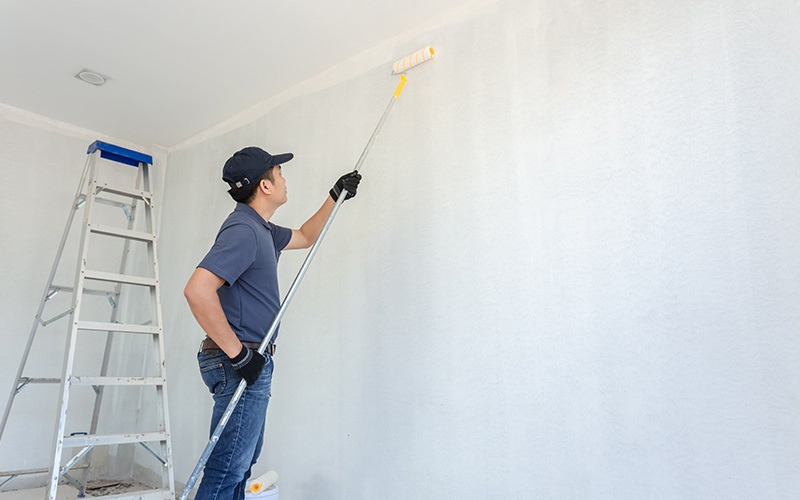You want a smooth, long-lasting paint job—and clear answers before you sign. The right questions can help you compare bids fairly, avoid unexpected costs and protect your house. Use this guide to interview companies with confidence and select a professional who meets your needs and budget.
How Many Coats of Paint Do You Include?
Coverage is important. A single pass is rarely enough for consistent color, sheen, and durability. Ask how many coats are typical, and if a primer is included for bare drywall, staining or dramatic color changes. Most professionals for indoor painting specify one coat of primer (when needed), and two finish coats; high-touch areas may require more.
Be very specific about the surfaces and rooms so the bid reflects reality. Ask if the ceiling and trim receive the same number of coats as the walls. This is also a good time to ask paint contractors how they handle prep work—filling in nail holes, sanding glossy surfaces, and caulking gaps—because the paint job’s (by many conditions) depends on how well the surface is prepared. The condition of the surface directly affects how many coats will look and last.
What Type of Paint Do You Use?
Not all products perform the same. Quality paint covers better, cleans better, and doesn’t fade as quickly. Ask which brand and line they suggest for your home and why. If you’re planning on an exterior painting job, you’ll want products designed for UV, rain and temperature changes.
Before you select a product, clarify the following:
- Whether the paint is low-VOC/zero-VOC, so it is safe for children, pets and sensitive noses. See here for more guidelines.
- The recommended finish (matte, eggshell, satin, semi-gloss) for each surface and how it will impact washability.
- Any specialty coatings for your climate and/or specific problem areas (stain-blocking primers, elastomeric, mildew resistant).
- How touch-up work will be done later- will the exact same product be easily available?
Do You Guarantee Your Work?
Written warranty denotes confidence and protects you in the event that you have a problem. Ask what is covered regarding the labor warranty (peeling, blistering, premature fading), and for how long. The manufacturer may give you a warranty on the product, but fine print usually excludes the installer from any issues caused by their errors. You may want both details in writing.
Double check the process for warranty claims- who inspects, what is considered “normal wear”, process for scheduling, etc. Verify the company has a license and is fully insured. Liability insurance and workers compensation protects you if a ladder falls over, or a spill damages your floor. Request proof and keep a copy with your contract.
What’s Included in the Estimate?
An accurate estimate protects you from having your change orders drive the price higher and higher. Ensure that the scope spells out rooms, square footage, and surfaces (walls, ceilings, trim, doors). Ask about how they handle moving furniture, masking, and cleaning up at the end of each day. Have clear language that indicates what surface preparation is included—patch, sanding, priming— so you can compare apples to apples.
You should also be looking for line items that include the following essentials: labor, materials, paint brand/line, number of coats for interior and/or exterior, any minor repairs, and any disposal. If color consultations are offered, be sure to ask if they are included in the estimate or if there will be an additional charge. Professional painting teams like Hatter Painters are willing to spend time with you to help you understand each line, as well as the many options that can affect your pricing and durability.
Do You Handle Repairs as Well as Painting?
Most houses need a little love before the first stroke of the brush. The little repairs are often what makes the final look or allows the paint to last longer. Ask the painter what repairs the crew can fix themselves and what repairs will require a technician. Find out how those prices would be estimated.
Before the work begins, verify who will be performing the repairs and the warranty:
- Interior repairs: drywall and plaster patching, seam patches/blending, and texture blending.
- Wood repairs: replacing rotten trim, resetting loose baseboards, caulking gaps/miscellaneous patching for clean lines.
- Exterior preparation: scraping and spot-priming weather areas, siding repairs, minor stucco, or masonry patch repairs.
- Stain and odor problems: sealing smoke or water-damaged areas with the proper primer paints.
Extra Smart Questions That Set You Up for Success
You will make a better decision if you are clear about communication and project flow. Let them know you want to communicate and ask the following questions: What is their project lead’s name and role? When does the crew plan to arrive and leave each day? How does the team plan to protect your floors, landscaping, and fixtures during the painting project/activities? Discuss options if there are pets and/or children in the house, and vents, and what access points into the rooms if necessary. Ask for a ‘sample wall’ or small test area to be painted to confirm color and sheen brightness under real-world lighting conditions.
Finally, ask for references, or at least some recent pictures of jobs they have completed similar to yours, if you are comfortable with this. A strong team will always provide you addresses (with the owner’s permission) or work portfolios to view. They will even provide you with little DIY touch-up ideas, and maintenance tips ranging from curing times to mild cleaners that help keep your finish looking fresher and new for a longer period of time.
Choosing the right pro comes down to clarity. When you ask these questions upfront, you will receive an accurate scope of work, your assigned products, and a finish that will take daily life. Remember to take notes while you meet with all the contractors, especially so you can compare quotes side by side to ultimately select the painting company who truly communicates with you and appears to care about your home. With a strong plan, you will get beautiful rooms that will stay beautiful.


